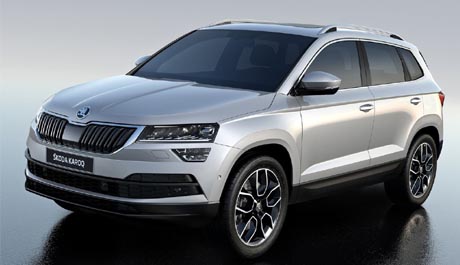Why Skoda changed the name Yeti to Koraq ?? [May 23, 2017]
 Skoda has taken the wraps off the Karoq SUV that replaces the Yeti in the Czech manufacturer’s line-up. The Karoq, which was unveiled in Stockholm, Sweden, is Skoda's challenger in Europe's fastest-growing market segment, going up against the likes of the Nissan Qashqai. The Karoq replaces the successful Yeti and is an all-new design built on the Volkswagen Group’s MQB platform. It also shares parts and technology with the similarly-sized Volkswagen Tiguan and Seat Ateca. The Karoq’s design, along with the Alaskan indigenous language-based naming convention, is based on the larger Kodiaq which will see an India launch in the coming months.
Skoda has taken the wraps off the Karoq SUV that replaces the Yeti in the Czech manufacturer’s line-up. The Karoq, which was unveiled in Stockholm, Sweden, is Skoda's challenger in Europe's fastest-growing market segment, going up against the likes of the Nissan Qashqai. The Karoq replaces the successful Yeti and is an all-new design built on the Volkswagen Group’s MQB platform. It also shares parts and technology with the similarly-sized Volkswagen Tiguan and Seat Ateca. The Karoq’s design, along with the Alaskan indigenous language-based naming convention, is based on the larger Kodiaq which will see an India launch in the coming months.
Skoda's CEO Bernhard Maier said, "With the Karoq, we are opening a new chapter in the success story of SUV at Skoda. The Yeti sold 100,000 cars per year, which was no less than 10 percent of global sales. We expect the Karoq to do more than that." The Karoq is also available with a range of advanced driver assistance and infotainment options and is the first Skoda to come with a digital instrument panel.
The decision to drop the popular Yeti name was in part to reinforce links to the Kodiaq, but also designed to help boost the car's global appeal. In China, one of the fastest-growing car markets where SUVs are hugely popular, the Yeti association is seen as a negative, given the Yeti folklore originates in Bhutan, a country China has no diplomatic relations with.
Skoda board member for sales and marketing Werner Eichhorn said: "We sold 550,000 units in 2006 and 1.1 million in 2016. China is our fastest growing market. The compact SUV segment is the growth segment in the industry. Sales in the segment have tripled in the last couple of years and that will continue. The Karoq sets a clear trend in its target segment." When asked about the name, Maier said the Chinese market was a factor in the decision, but also cited a desire to ensure the Karoq had a unique identity. He said: "Starting with the Kodiaq, we thought a K and a Q was a perfect fit for our SUV, so we think it's worth the name Karoq. In China, indeed [the Yeti name] is, let’s say, polarised. With the Karoq, we don’t see that any more. Karoq is its own unique name, and you can’t take it differently or in a bad way. And Karoq has a nice story behind it."
The Karoq will be offered with two petrol engines: a 1.0-litre TSI three-cylinder with 115hp, a 1.5-litre TSI with 150hp. The latter, which features active cylinder technology, can do 0-100kph in 8.4sec. The three diesel engines include a 2.0 TDI with 150hp that has already featured in Skoda’s range. The other two are new: a 1.6 TDI with 115hp, and a range-topping 2.0 TDI with 189hp. The new 2.0 TDI engine comes with a seven-speed DSG gearbox as standard, while the others are available with a six-speed manual as well.
The Karoq is available in two- and four-wheel-drive. Higher specs will come with a Driving Mode Select system, offering five options: Normal, Sport, Eco, Individual and Snow. Off-road mode, featuring traction control and electronic differential lock will be an option on four-wheel-drive models.
The Karoq features a MacPherson-designed front axle with triangular wishbones and a four-link rear axle. A Dynamic Chassis Control system on the 1.5 TSI and both 2.0 TDI engines will offer three chassis modes – Comfort, Standard and Sport – with electrically operated valves adjust based on road conditions. A range of driver assistance systems will be available, including a Front Assist autonomous emergency braking system as standard. Other systems available include adaptive cruise control, blindspot detect, rear traffic alert, traffic sign recognition and lane assist.
The Karoq will be the first Skoda to feature a customisable digital instrument panel. It will also come with three individual keys, which will remember a driver’s preferred drive mode, lighting, infotainment and other settings when they unlock the car.
There are four levels of infotainment system. The top level, Columbus, features a 9.2in screen and gesture control for certain functions. Other features include a wireless smartphone charging pad and adjustable interior ambient lighting, along with a heated steering wheel, heated rear seats, virtual pedal, hands-free boot system and an electronically-retractable tow bar.
The Karoq has space for five passengers, with a 521-litre boot capacity, which expands to 1,630 litres with the rear seats folded. A VarioFlex system allows the three rear seats to be individually adjusted or removed, expanding capacity to 1,810 litres. Skoda is yet to confirm final pricing or an on-sale date for the Karoq. It will be available later this year. There is no news on an India launch for this SUV.